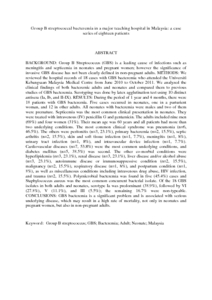Citation
Eskandarian, Narges and Neela, Vasantha Kumari and Ismail, Zalina and Mohd Puzi, Shaliawani and Awang Hamat, Rukman and Mohd Desa, Mohd Nasir and Amin Nordin, Syafinaz
(2013)
Group B streptococcal bacteremia in a major teaching hospital in Malaysia: a case series of eighteen patients.
International Journal of Infectious Diseases, 17 (9).
e777-e780.
ISSN 1201-9712; ESSN: 1878-3511
Abstract
BACKGROUND: Group B Streptococcus (GBS) is a leading cause of infections such as meningitis and septicemia in neonates and pregnant women; however the significance of invasive GBS disease has not been clearly defined in non-pregnant adults.
METHODS: We reviewed the hospital records of 18 cases with GBS bacteremia who attended the Universiti Kebangsaan Malaysia Medical Centre from June 2010 to October 2011. We analyzed the clinical findings of both bacteremic adults and neonates and compared them to previous studies of GBS bacteremia. Serotyping was done by latex agglutination test using 10 distinct antisera (Ia, Ib, and II-IX).
RESULTS: During the period of 1 year and 4 months, there were 18 patients with GBS bacteremia. Five cases occurred in neonates, one in a parturient woman, and 12 in other adults. All neonates with bacteremia were males and two of them were premature. Septicemia was the most common clinical presentation in neonates. They were treated with intravenous (IV) penicillin G and gentamicin. The adults included nine men (69%) and four women (31%). Their mean age was 60 years and all patients had more than two underlying conditions. The most common clinical syndrome was pneumonia (n=6, 46.5%). The others were peritonitis (n=3, 23.1%), primary bacteremia (n=2, 15.5%), septic arthritis (n=2, 15.5%), skin and soft tissue infection (n=1, 7.7%), meningitis (n=1, 8%), urinary tract infection (n=1, 8%), and intravascular device infection (n=1, 7.7%). Cardiovascular diseases (n=7, 53.8%) were the most common underlying conditions, and diabetes mellitus (n=5, 38.5%) was second. The other co-morbid conditions were hyperlipidemia (n=3, 23.1%), renal disease (n=3, 23.1%), liver disease and/or alcohol abuse (n=3, 23.1%), autoimmune disease or immunosuppressive condition (n=2, 15.5%), malignancy (n=2, 15.5%), respiratory disease (n=1, 8%), and postpartum condition (n=1, 8%), as well as miscellaneous conditions including intravenous drug abuse, HIV infection, and trauma (n=2, 15.5%). Polymicrobial bacteremia was found in five (45.4%) cases and Staphylococcus aureus was the most common concurrent bacterial isolate. Of the 18 GBS isolates in both adults and neonates, serotype Ia was predominant (38.9%), followed by VI (27.8%), V (11.1%), and III (5.5%); the remaining 16.7% were non-typeable.
CONCLUSIONS: GBS bacteremia is a significant problem and is associated with serious underlying disease, which may result in a high rate of mortality, not only in neonates and pregnant women, but also in non-pregnant adults.
Download File
![[img]](http://psasir.upm.edu.my/29649/1.hassmallThumbnailVersion/Group%20B%20streptococcal%20bacteremia%20in%20a%20major%20teaching%20hospital%20in%20Malaysia.pdf)  Preview |
|
PDF (Abstract)
Group B streptococcal bacteremia in a major teaching hospital in Malaysia.pdf
Download (86kB)
| Preview
|
|
Additional Metadata
Actions (login required)
 |
View Item |

